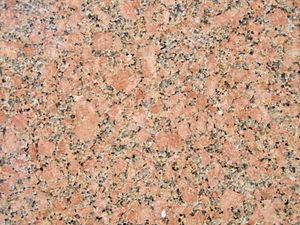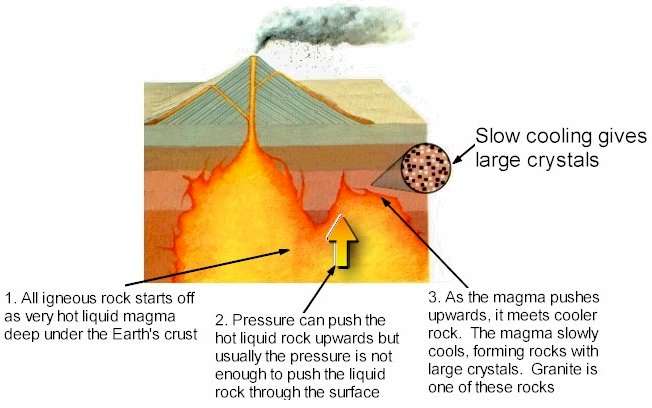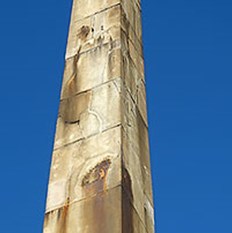Swe:
Granit
Granit är en av de vanligaste bergarterna på den kontinentala jordskorpan. Granit har en grov- till finkornig struktur. Stora delar av Sveriges berggrund utgörs av granit, särskilt i Småland och Norrland.
Granit bygger tillsammans med tonalit och granodiorit upp en stor del av kontinentskorpan. Den består av kvarts (grå), kalifältsspat (vit eller rosa) och plagioklas (vit) samt varierande mängder muskovit (ljus), biotit (svart) och hornblände (svart); färgen är grå- eller röd-spräcklig beroende på fältspatens färg.

Magmatiska bergarter
Granit är en magmatisk bergart, djupbergart om man ska vara mer specifik. Magmatiska bergarter, magmabergarter, bildas som stelningsprodukter av magmor (bergartssmältor) i eller ovanpå jordskorpan. I motsats till ett rent ämne (grundämne eller kemisk förening) saknar en magma specifik stelningstemperatur. När magman svalnar sker därför stelnandet, kristallisationen, inom ett stort temperaturintervall. Vid stelnandet utfäller magman normalt kristaller av flera olika mineral.
Det finns flera olika sorters magmatiska bergarter. Vulkanit (vulkaniska bergarter) är en magmatisk bergart och bildas av snabbt avkylnande magma på eller ytligt under jordytan. Som resultat av detta så blir vulkaniska bergarter glasiga eller finkornigt kristallina. Exempel på vulkaniska bergarter är tuff, ignimbrit och pimpsten.
Magmatiska djupbergarter bildas av magma. När magma trycks upp så svalnar den eftersom att den trycks mot kallare stenar. Långsamt så stelnar magman. Så bildas granit och andra magmatiska djupbergarter.

Stockholmsgranit
Stockholmsgranit är en typ av granit som finns i Stockholmsregionen. Graniten bildades för ungefär 1800 miljoner år sedan och kommer från Stockholmsregionens urberg. Som all form av granit så bildades Stockholmsgraniten av magma som har långsamt stelnat djupt ned i jordskorpan. Graniten har oftast en grå färg med svarta korn och har ibland större kristaller av kalifältspat. Den har använts till gatsten och byggnadssten.

Bohusgranit
Bohusgranit är den yngsta graniten i Sveriges urberg med en ålder på cirka 900 miljoner år. Graniten är en rödaktig eller grå granit som finns i bland annat norra Bohuslän. Den är fin- eller medelkornig och innehåller talrika gångar och sliror av bergarten pegmatit.
Obelisken
Obelisken i Stockholm är en 22 meter hög obelisk och uppfördes under åren 1798 till 1800. Obelisken är gjord utav Stockholmsgranit och graniten på Obelisken kommer ifrån Ulvsunda.
Restaureringsarbetet
I januari 2017 påbörjades restaurering av obelisken vid Slottsbacken. Obeliskens 17 granittrummor hade alla blivit skadade och drabbade av bland annat sprickor och spruckna fogar. För att undvika rasrisken var man tvungen att montera ned den, och då de ursprungliga delarna var skadade så behövde de ersättas med nya.

Under 2020 påbörjades resningen av den nya obelisken, som består av bohuslänsk granit från Tossene och har liknande tekniska och estetiska egenskaper som den ursprungliga.
Earthcachen
Om du vill logga den här earthcachen som "found" så ska du besöka koordinaterna ovan som leder till Obelisken på Slottsbacken. Du ska även svara på frågorna här nedanför.
1. Kolla på överdelen av Obelisken (ej sockeln): Är graniten finkornig eller grovkornig? Är graniten mycket eller lite finkornig/grovkornig? Vilken färg har har Obelisken? Vad tror du att graniten innehåller mycket av (av kvarts, kalifältsspat, plagioklas med mera) med tanke på granitens färg?
2. Granit är en av de vanligaste bergarterna. Med tanke på hur granit bildas, varför tror du att granit är så pass vanlig?
3. Varför tror du att man har använt granit till Obelisken? Brukar granit ha sprickor i sig? Är granit lätt att bryta sönder?
Obs, frivilligt: ta en bild på dig och din GPS med Obelisken.
Skicka svaren på frågorna till mig via mail. Du behöver inte vänta på bekräftelse från mig men om det skulle vara något fel så kontaktar jag dig. Kom ihåg att inte skriva några svar i loggen. Loggar som inte uppfyller dessa krav kommer att raderas.
Eng:
Granite
Granite is one of the most common rocks in the continental crust of the earth. Granite is a magmatic rock, which means that it is created when magma deep down in earth goes through a slow cooling process. Granite has a rough structure. Large part of Swedens bedrock consists of granite, mostly in Småland and in Norrland.
The term 'granite' also applies to a group of intrusive igneous rocks with similar textures and slight variations on composition and origin. These rocks mainly consist of feldspar (white or pink), quartz (grey), plagioclase (white) and various amounts of muscovite (light), biotite (black) and hornblende (black) .

Igneous rock
Granite is an Igneous rock, intrusive igneous rock to be more specific. Igneous rock is created when magma cools down and solidifies in or on earths crust. Igneous rock may form with or without crystallization.
Volcanic rock is a rock formed from magma erupted from a volcano. The magma solidifies fast and as a result of that, volcanic rocks are usually fine-grained or aphanitic to glass in texture.
Intrusive igneous rocks are formed when magma is pressed against pre-existing rock because of pressure. The pre-existing rocks are colder which leads to that the magma slowly cools. That is how granite is created.

Stockholm granite
Stockholm granite is a type of granite which can be found in the Stockholm region. The granite is approximately 1800 millions year old and comes from the primary rock in Stockholm. Like all types of granite it is formed when magma slowly cools deep down in the earths crust. It is often gray with black grains and sometimes have red crystals out of feldspar. It is used for cobblestone, masonry and so forth.
Bohus granite
Bohus granite is the youngest granite in Swedens bedrock with an age of about 900 million years. The granite is a reddish or grey granite wich can be found in amongst other in northern Bohuslän. The granite has a fine to medium grained structure.
The Obelisk at Slottsbacken
The Obelisk is 22 meters tall and was raised in 1798 to 1800. It is made out of Stockholm granite and the granite is from Ulvsunda, Sweden.
During 2017 to 2020 the obelisk was renovated due to the fact that the parts was quite damaged and was replaced with new building blocks from "Bohuslän", Sweden.
This earthcache
If you want to log this earthcache you have to visit the above coordinates which leads to the Obelisk at Slottsbacken. To log this cache you also have to answer the questions.
Update: From now on I will not answer every email with answers. Send me your answer and then log the earthcache, and if you have to send new answers then I will contact you.
1. Look at the granite of the upper part of the Obelisk (not the base of the Obelisk): Is the granite rough-grained or fine-grained? Is it very or little rough-grained or fine-grained? What colour does the Obelisk have? What do you think the granite mostly consists of (If its consists most of feldspar, quartz, plagioclase and so forth) because of its colour?
2. Granite is one of the most common rocks. Why do you think that?
3. Why do you think that granite is used for the Obelisk? Does granite often have cracks in it? Does granite easily break?
If you want you can upload a picture of you and your GPS with the obelisk. This is not a requirement.
Email me your answers. You dont need to wait for my confirmation but if there is something wrong i will contact you. Remember to not write the anwers in the log. Logs which dont fulfill the requirements to log will be deleted.

